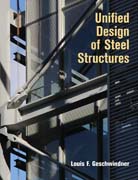
Study the design of steel building structures per the 2005 unified specification, ANSI/AISC 360-05 Specification for Structural Steel Buildings with this key resource. Author Louis F. Geschwindner first builds the foundation for steel design and then explores the various member types in more detail. He provides guidance for those new to the field as well as an excellent review for practicing engineers looking to learn the provisions of the unified specification and to convert their practice from the old specifications to the new one. INDICE: 1. Introduction.1.1 Scope.1.2 Principles of Structural Design.1.3 The Parts of the Steel Structure.1.4 Types of Steel Structures.1.5 Design Philosophies.1.6 Fundamentals of Allowable Strength Design (ASD).1.7 Fundamentals of Load and Resistance Factor Design (LRFD).1.8 Inelastic Design.1.9 Structural Safety.1.10 Limit States.1.11 Building Codes and Design Specifications.2. Loads, Load Factors, and Load Combinations.2.1 Introduction.2.2 Building Load Sources.2.3 Building Load Determination.2.4 Load Combinations for ASD and LRFD.2.5 Load Calculations.2.6 Calibration.2.7 Problems.3. Steel Building Materials.3.1 Introduction.3.2 Applicability of the AISC Specification.3.3 Steel for Construction.3.4 Structural Steel Shapes.3.5 Chemical Components of Structural Steel.3.6 Grades of Structural Steel.3.7 Availability of Structural Steel.4. Tension Members.4.1 Introduction.4.2 Tension Members in Structures.4.3 Cross-Sectional Shapes for Tension Members.4.4 Behavior and Strength of Tension Members.4.5 Computation of Areas.4.6 Design of Tension Members.4.7 Block Shear.4.8 Pin-Connected Members.4.9 Eye-bars and Rods.4.10 Built-up Tension Members.4.11 Truss Members.4.12 Bracing Members.5. Compression Members.5.1 Compression Members in Structures.5.2 Cross-Sectional Shapes for Compression Members.5.3 Compression Member Strength.5.4 Additional Limits States for Compression.5.5 Length Effects.5.6 Slender Elements in Compression.5.7 Column Design Tables.5.8 Torsional Buckling and Flexural-Torsional Buckling.5.9 Single Angle Compression Members.5.10 Built-Up Members.6. Bending Members.6.1 Bending Members in Structures.6.2 Strength of Beams.6.3 Design of Compact Laterally Supported Wide Flange Beams.6.4 Design of Compact Laterally Unsupported Wide Flange Beams.6.5 Design of Noncompact Beams.6.6 Design of Beams for Weak Axis Bending.6.7 Design of Beams for Shear.6.8 Continuous Beams.6.9 Plastic Analysis and Design of Continuous Beams.6.10 Provisions for Double-Angle and Tee Members.6.11 Single Angle Bending Members.6.12 Members in Biaxial Bending.6.13 Serviceability Criteria forBeams.6.14 Concentrated Forces on Beams.7. Plate Girders.7.1 Background.7.2 Homogeneous Plate Girders in Bending.7.3 Homogeneous Plate Girders in Shear.7.4Stiffeners for Plate Girders.8. Beam-Columns and Frame Behavior.8.1 Introduction.8.2 Second-Order Effects.8.3 Interaction Principle.8.4 Interaction Equations.8.5 Braced Frames.8.6 Moment Frames.8.7 Specification Provisions for Stability Analysis and Design.8.8 Initial Beam-Column Selection.8.9 Beam-column Design Using Manual Part 6.8.10 Combined Simple and Rigid Frames.8.11 Partially Restrained (PR) Frames.8.12 Bracing Design.9. Composite Construction.9.1 Introduction.9.2 Advantages and Disadvantages of Composite Beam Construction.9.3 Shored vs. Unshored Construction.9.4 Effective Flange.9.5 Strength of Composite Beams and Slab.9.6 Shear Stud Capacity.9.7 Composite Beams with Formed Metal Deck.9.8 Fully Encased Steel Beams.9.9 Selecting a Section.9.10 Serviceability Considerations.9.11 Composite Columns.9.12 Composite Beam-Columns.10. ConnectionElements.10.1 Introduction.10.2 Basic Connections.10.3 Beam-to-Column Connections.10.4 Fully Restrained Connections.10.5 Simple and Partially Restrained Connections.10.6 Mechanical Fasteners.10.7 Bolt Limit States.10.8 Welds.10.9 Weld Limit States.10.10 Connecting Elements.10.11 Problems.11. Simple Connections.11.1 Types of Simple Connections.11.2 Simple Shear Connections.11.3 Double-Angle Connections: Bolted-Bolted.11.4 Double-Angle Connections: Welded-Bolted.11.5 Double-Angle Connections: Bolted-Welded.11.6 Double-Angle Connections: Welded-Welded.11.7 Single Angel Connections.11.8 Single Plate Shear Connections.11.9 Seated Connections.11.10 Light Bracing Connections.12. Moment Connections.12.1 Types of Moment Connections.12.2 Limit States.12.3 Moment Connection Design.12.4 Column Stiffening.13. Steel Systems for Seismic Resistance.13.1 Introduction.13.2 Expected Behavior.13.3 Moment-Frame Systems.13.4 Braced-Frame Systems.13.5 Other Framing Systems.13.6 Other General Requirements.13.7 Conclusions.Index.
- ISBN: 978-0-471-47558-3
- Editorial: John Wiley & Sons
- Encuadernacion: Cartoné
- Páginas: 444
- Fecha Publicación: 01/01/2008
- Nº Volúmenes: 1
- Idioma: Inglés
